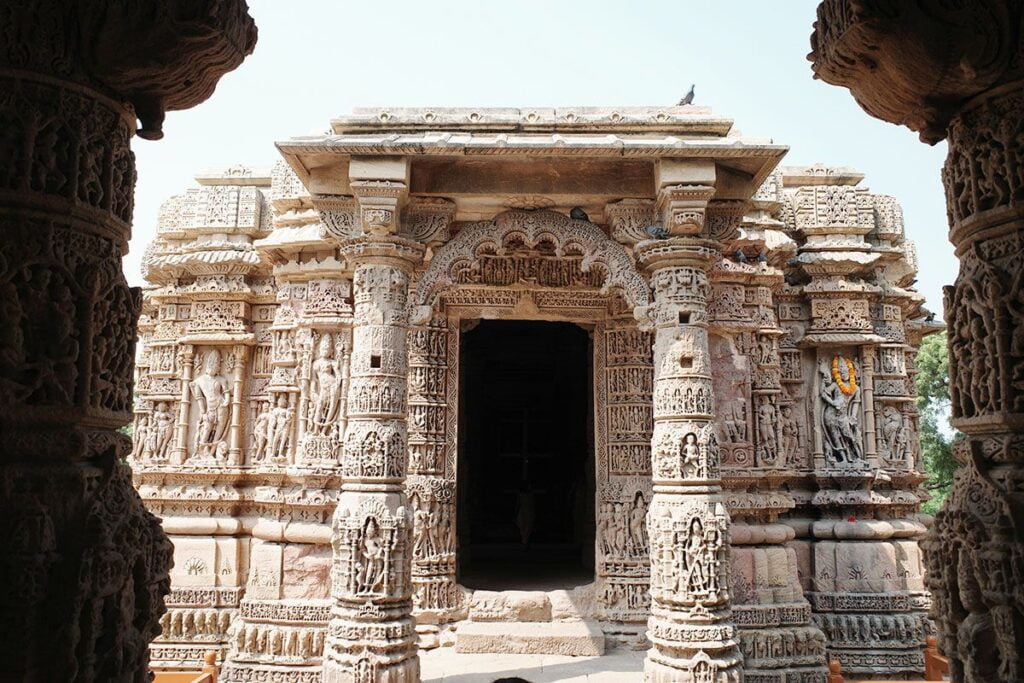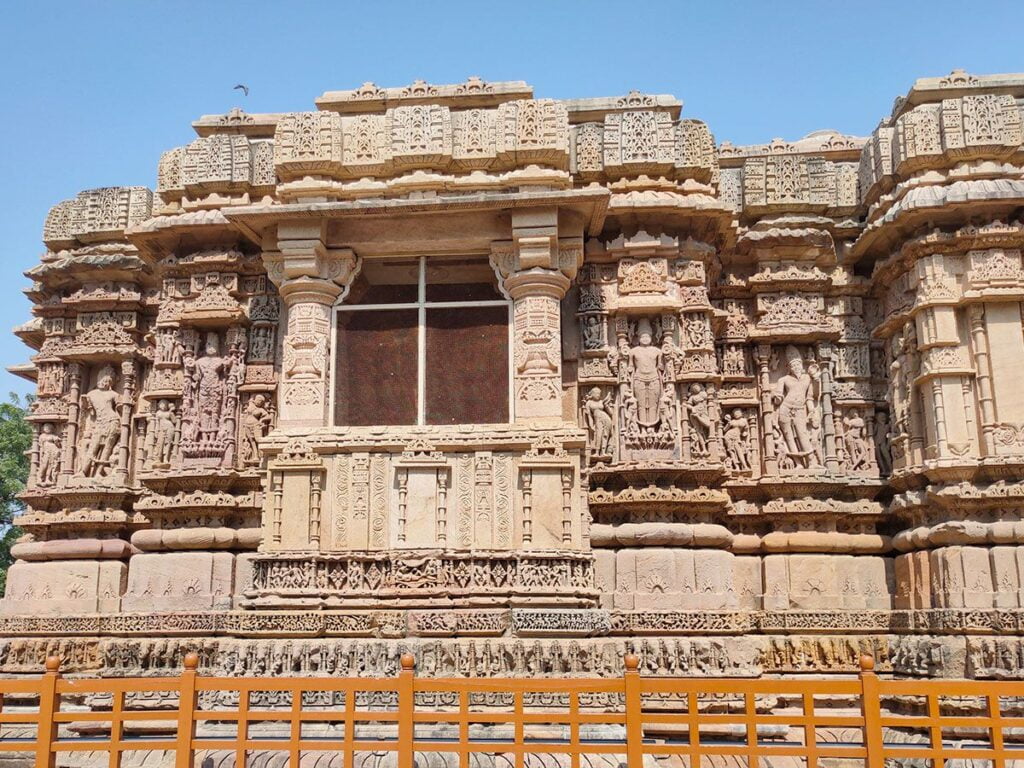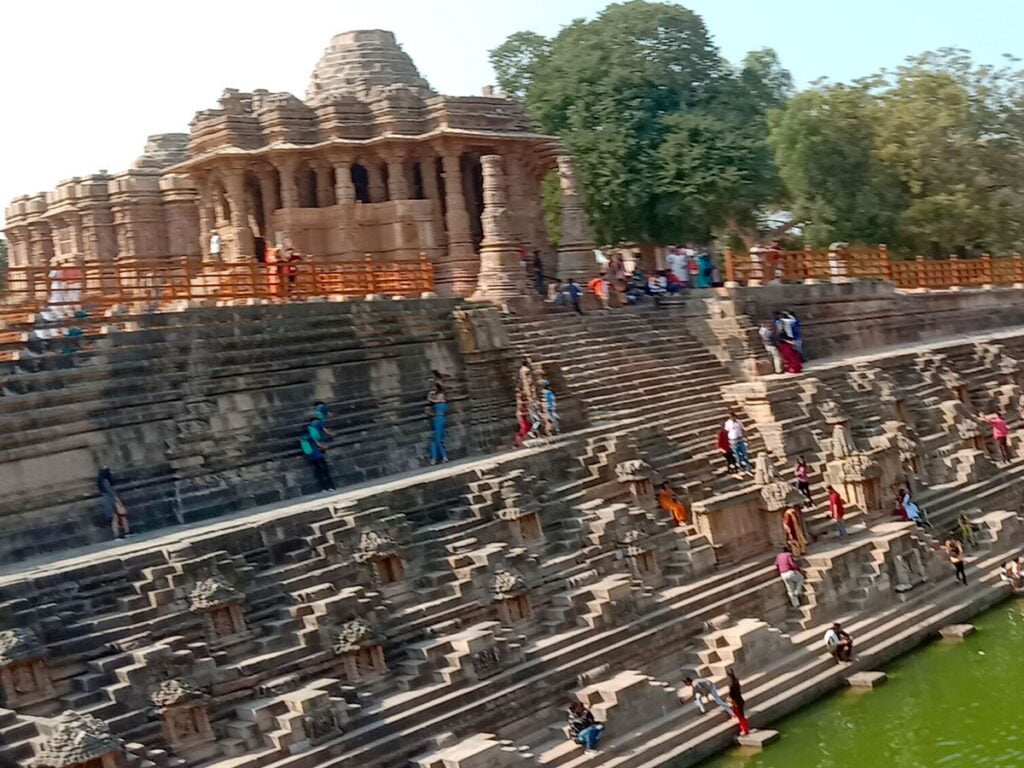Modhera Sun Temple: India’s Sunken City of Light
The Modhera Sun Temple is a Hindu temple dedicated to the solar deity Surya located at Modhera village of Mehsana district, Gujarat, India. It is situated on the bank of the river Pushpavati. It was built after 1026-27 CE during the reign of Bhima I of the Chaulukya dynasty. No worship is offered now and is protected monument maintained by Archaeological Survey of India.

Contents
- 1 Modhera Sun Temple History:
- 2 Legend of Modhera Sun Temple:
- 3 Significance of Modhera Sun Temple:
- 4 Myths of Modhera Sun Temple:
- 5 Architecture of Modhera Sun Temple:
- 6 Places to visit near Modhera Sun Temple:
- 7 FAQ:
- 7.1 Q1: Where is the Modhera Sun Temple located?
- 7.2 Q2: What is the historical significance of the Modhera Sun Temple?
- 7.3 Q3: What is unique about the architecture of the Modhera Sun Temple?
- 7.4 Q4: Can visitors still witness rituals or ceremonies at the Modhera Sun Temple?
- 7.5 Q5: What is Surya Kund, and why is it significant?
- 7.6 Q6: Is photography allowed inside the temple premises?
- 7.7 Q7: What is the best time to visit the Modhera Sun Temple?
- 7.8 Q8: Are there any nearby attractions to explore along with the Modhera Sun Temple?
- 7.9 Q9: Is there an entry fee to visit the Modhera Sun Temple?
- 7.10 Q10: Can visitors hire guides for a tour of the Modhera Sun Temple?
- 8 How to reach Modhera Sun Temple:
- 9 Google Maps:
Modhera Sun Temple History:
Origins:
- Built around 1026-27 CE by King Bhima I of the Chaulukya dynasty, also known as Solankis.
- The Solankis believed themselves to be descendants of the Sun God, hence the temple’s dedication to Surya (Sun).
- The temple’s construction coincided with a peak in Indian temple architecture, marking a significant contribution.
Architectural Marvel:
- The complex comprises three main structures:
- Gūḍhamanḍapa: The shrine hall, where the idol of Surya once stood (now missing).
- Sabhamanḍapa: The assembly hall, adorned with intricate carvings depicting mythological scenes and deities.
- Kunḍa: A rectangular reservoir with 108 shrines dedicated to various gods and goddesses.
- The intricate carvings and sculptures showcase the prowess of Solanki architecture, blending Maratha and Gurjara styles.
Challenges and Transformation:
- The temple faced invasions by Mahmud of Ghazni and Alauddin Khilji, leading to damage and plunder.
- Despite the destruction, the temple’s foundations remained strong.
- Today, the temple is not actively used for worship but stands as a protected monument under the Archaeological Survey of India.
Read More>> Arasavalli Temple | Sri Suryanarayana Swamy Temple

Legend of Modhera Sun Temple:
According to a legend, the Sun Temple of Modhera was built by the Sun God himself. It is said that the Sun God was pleased with the devotion of a local king named Bhima I. He appeared to the king in a dream and instructed him to build a temple in his honor. The king obeyed the Sun God’s command and built the temple at Modhera.
Another legend tells the story of a beautiful apsara named Modhera. She was the daughter of the Sun God and was known for her beauty and dancing skills. One day, she was dancing in the heavens when she saw a handsome prince named Bhima I. She was immediately smitten with him and descended to earth to meet him. The prince was also captivated by her beauty and they fell in love.
The couple got married and lived happily ever after. However, their happiness was not to last. One day, a demon named Ravana attacked the kingdom. The prince was killed in battle and Modhera was taken captive. Ravana took her to his kingdom in Lanka and imprisoned her.
Modhera prayed to her father for help. The Sun God heard her prayers and sent an army of monkeys to rescue her. The monkeys defeated Ravana and rescued Modhera. She was reunited with her husband and they lived happily ever after.
Read More>> Konark Sun Temple 13th Century Gem

Significance of Modhera Sun Temple:
Historically:
- Dynastic connection: Built by King Bhima I of the Chalukya dynasty (also known as Solankis) in the 11th century, it served as a dedication to Surya, the sun god, believed to be the dynasty’s ancestor.
- Architectural marvel: It showcases the peak of Maru-Gurjara architecture, evident in its intricate carvings, pillars, and halls.
- Possible commemoration: Historian A.K. Majumdar suggests it might have been built to commemorate the unsuccessful defense against Mahmud of Ghazni’s invasion.
Religiously:
- Devotion to Surya: It stands as one of the few major temples dedicated to Surya, signifying the importance of the sun god in Hinduism.
- Symbolic alignment: The temple’s alignment allows sunlight to directly illuminate the sanctum sanctorum during equinoxes, highlighting the connection between the sun and the divine.
- Sacredness: Though worship is not currently practiced, the temple still holds spiritual significance for many.
Artistically:
- Exquisite carvings: The temple boasts intricate carvings depicting gods, goddesses, flora, fauna, and geometric patterns, showcasing the artistic mastery of the era.
- Harmony with nature: Its setting on the Pushpavati River and the adjacent Surya Kund reservoir represent the integration of architecture with the natural world.
Read More>> Nageshwar Jyotirlinga Dwaraka: 7th CE Temple with Divine Powers

Myths of Modhera Sun Temple:
1. Sun God’s First Rays: One popular legend states that the temple was designed to ensure the first rays of the rising sun on the equinoxes would illuminate the sanctum sanctorum where the Sun God’s idol resided. Supposedly, a diamond on the idol’s crown would then reflect the light, illuminating the entire temple. This aligns with the temple’s intricate astronomical alignments, but the exact mechanism remains a subject of debate.
2. Destruction and Rebuilding: Another narrative describes the temple’s destruction by Mahmud of Ghazni or Allaudin Khilji, followed by its reconstruction. While historical evidence supports invasions and damage, the exact sequence and extent of destruction are contested. This narrative reflects the turbulent history of the region and the temple’s resilience.
3. Aditya’s as Base Myth: Some associate the temple with the “Adityas,” the twelve manifestations of the Sun God corresponding to the months. Carvings depicting them are found on the temple walls, leading some to believe they served as the inspiration for the temple’s dedication to the Sun God.
4. Sun God Idol Theft: Legends suggest that invaders like Mahmud of Ghazni or Allaudin Khilji plundered a golden idol of the Sun God from the temple. While the idol’s existence is uncertain, the narrative highlights the temple’s perceived wealth and historical context.
5. Land Grant for Wedding Gift: A less widely known story claims the land where the temple stands was gifted to the Modha Brahmins as a wedding present during the marriage of Ram and Sita. While this tale lacks historical evidence, it reflects the temple’s connection to local legends and cultural beliefs.
Read More>> 2500 Years Dwarkadhish Temple: Where Miracles Still Happen

Architecture of Modhera Sun Temple:
Tripartite Structure:
- Garbhagriha (Shrine): The innermost sanctum houses the idol of Surya. It is built on a raised platform shaped like an inverted lotus, symbolizing the sun’s emergence from the darkness.
- Gudhamandapa (Hall): This mandapa connects the garbhagriha to the sabhamandapa. It is adorned with intricate sculptures depicting scenes from Hindu mythology.
- Sabhamandapa (Assembly Hall): This is the largest structure in the complex and served as a gathering place for devotees. It is supported by intricately carved pillars and features beautiful ceiling panels. Sadly, the roof of the sabhamandapa has collapsed over time.
Maru-Gurjara Style:
- The temple is built in the Maru-Gurjara style of architecture, characterized by its use of sandstone, intricate carvings, and pyramidal shikharas (spires).
- The temple’s exterior is adorned with a profusion of sculptures depicting deities, mythical creatures, and geometric patterns.
Alignment with the Sun:
- One of the most remarkable features of the temple is its alignment with the sun. On the days of the equinoxes (March 21 and September 21), the first rays of the sun illuminate the idol of Surya in the garbhagriha. This alignment is believed to be a symbolic representation of the sun’s life-giving power.
Surya Kund (Stepwell):
- The temple complex also includes a stepwell called Surya Kund. This stepwell served as a bathing ghat for devotees and is adorned with numerous shrines and sculptures.
Read More>> Prabhas Shakti Peeth Chandrabhaga
Places to visit near Modhera Sun Temple:
- Patan: Patan is known for its Rani Ki Vav, a UNESCO World Heritage Site and a stepwell with intricate carvings. The city also has the Sahasralinga Talav, Sahastra Bahu Temples, and the Patola Heritage Museum.
- Ahmedabad: The largest city in Gujarat, Ahmedabad, is known for its vibrant culture, historical sites, and delicious street food. Some places of interest include the Sabarmati Ashram, Jama Masjid, Sarkhej Roza, and the Calico Museum of Textiles.
- Adalaj Stepwell: Located near Ahmedabad, the Adalaj Stepwell is a beautifully carved stepwell that is worth a visit. It’s an excellent example of Indo-Islamic architecture.
- Ambaji: Ambaji is a pilgrimage town known for the Ambaji Temple, one of the 51 Shakti Peethas. The temple is situated on the Arasur hill and attracts devotees from all over.
- Mehsana: Mehsana is known for its historical and cultural significance. The Mehsana stepwell, Modhera’s Surya Kund, and the Dudhsagar Dairy are some places to explore in Mehsana.
- Sidhpur: Sidhpur is famous for its Bohra Havelis, Rudra Mahalaya Temple, and the Bindu Sarovar. The town has a rich architectural heritage.
- Gandhinagar: The capital of Gujarat, Gandhinagar, is known for the Akshardham Temple, which is an architectural marvel. The city also has the Sarita Udyan, Indroda Nature Park, and Adalaj Trimandir.
- Taranga Hills: Located near Mehsana, Taranga Hills is known for its Jain temples and the scenic beauty of the hills. The Shri Shantinath Jain Temple is a prominent attraction here.
- Rann of Kutch: If you’re willing to travel a bit further, the Rann of Kutch is known for its white salt desert during the Rann Utsav. It offers a unique cultural experience with vibrant folk performances and handicrafts.
Read More>> Shree Somnath Jyotirling Temple: The Shrine of Eternal Light
FAQ:
Q1: Where is the Modhera Sun Temple located?
A: The Modhera Sun Temple is located in the town of Modhera in the Mehsana district of Gujarat, India.
Q2: What is the historical significance of the Modhera Sun Temple?
A: The temple was built in the 11th century during the reign of King Bhimdev I of the Solanki dynasty. It is dedicated to the Hindu Sun God, Surya, and is an exemplary representation of ancient Indian architecture and art.
Q3: What is unique about the architecture of the Modhera Sun Temple?
A: The temple is renowned for its intricate architecture, with a sanctum, assembly hall, and a reservoir called Surya Kund. The intricate carvings and detailed sculptures depict various mythological stories and celestial beings.
Q4: Can visitors still witness rituals or ceremonies at the Modhera Sun Temple?
A: While the temple is not an active site for daily rituals, special events like the Modhera Dance Festival are held annually, showcasing traditional dance forms against the backdrop of the stunning temple architecture.
Q5: What is Surya Kund, and why is it significant?
A: Surya Kund is a large rectangular stepped tank located in front of the temple. It is believed that taking a dip in the holy waters of Surya Kund purifies the soul. The Kund also served as a water reservoir for pilgrims.
Q6: Is photography allowed inside the temple premises?
A: Yes, photography is generally allowed in the outer premises of the temple. However, it’s advisable to check with the authorities on any specific guidelines or restrictions during your visit.
Q7: What is the best time to visit the Modhera Sun Temple?
A: The ideal time to visit is during the winter months, from October to March, when the weather is pleasant. It’s advisable to avoid the scorching summer months.
Q8: Are there any nearby attractions to explore along with the Modhera Sun Temple?
A: Yes, the Sun Temple is situated near the Rani ki Vav, a UNESCO World Heritage site. It’s an intricately constructed stepwell with stunning sculptures.
Q9: Is there an entry fee to visit the Modhera Sun Temple?
A: Yes, there is usually a nominal entry fee for Indian and foreign tourists. It is recommended to check the current fees before planning your visit.
Q10: Can visitors hire guides for a tour of the Modhera Sun Temple?
A: Yes, there are guides available at the site who can provide detailed insights into the history, architecture, and significance of the Modhera Sun Temple. Hiring a guide can enhance your overall experience.
How to reach Modhera Sun Temple:
- By Air: The nearest airport to Modhera is Sardar Vallabhbhai Patel International Airport in Ahmedabad, which is approximately 102 kilometers away. From the airport, you can hire a taxi or use other modes of transportation to reach Modhera.
- By Train: The nearest railway station is Mehsana Junction, which is around 25 kilometers from Modhera. After reaching Mehsana Junction, you can hire a taxi or use local transportation to reach the temple.
- By Road: Modhera is well-connected by road. You can use buses or hire a taxi from nearby cities like Ahmedabad or Gandhinagar. The temple is situated on the bank of the Pushpavati River and is easily accessible by road.

One Comment